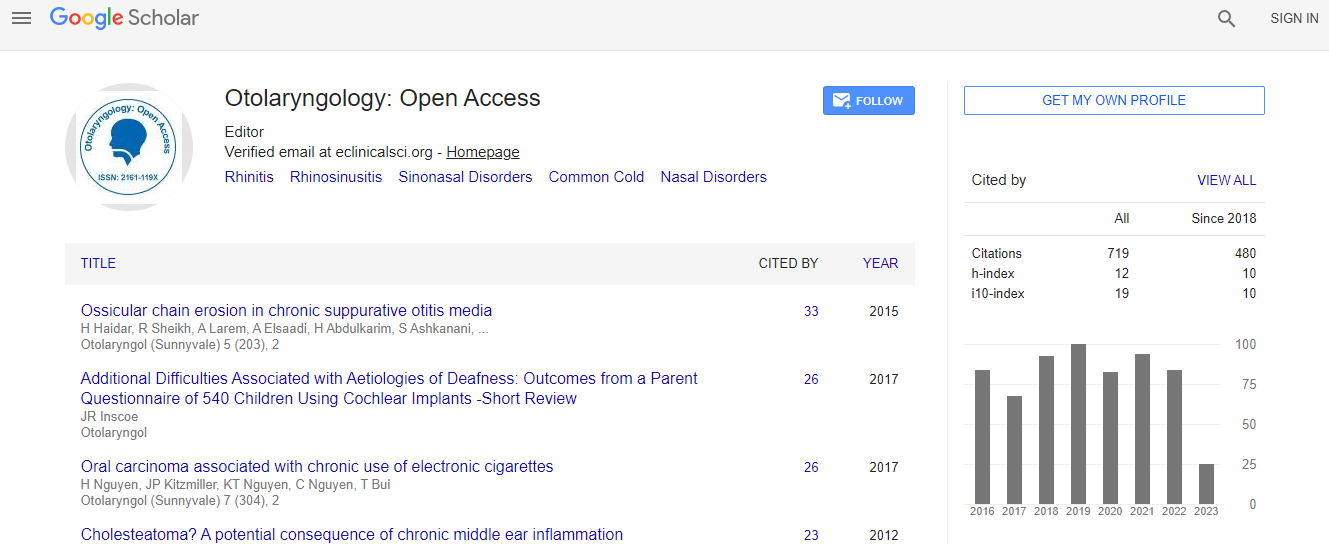Our Group organises 3000+ Global Conferenceseries Events every year across USA, Europe & Asia with support from 1000 more scientific Societies and Publishes 700+ Open Access Journals which contains over 50000 eminent personalities, reputed scientists as editorial board members.
Open Access Journals gaining more Readers and Citations
700 Journals and 15,000,000 Readers Each Journal is getting 25,000+ Readers
Google Scholar citation report
Citations : 925
Otolaryngology: Open Access received 925 citations as per Google Scholar report
Otolaryngology: Open Access peer review process verified at publons
Indexed In
- Index Copernicus
- Google Scholar
- Sherpa Romeo
- Open J Gate
- Genamics JournalSeek
- RefSeek
- Hamdard University
- EBSCO A-Z
- OCLC- WorldCat
- Publons
- Geneva Foundation for Medical Education and Research
- ICMJE
Useful Links
Recommended Journals
Related Subjects
Share This Page
Feature and etiology of unilateral vocal fold paralysis and its surgical treatment
3rd International Conference and Exhibition on Rhinology & Otology
Ryoji Tokashiki
Tokyo Medical University, Japan
Keynote: Otolaryngology
Abstract
Objective: In this presentation, I will talk about the passive movement of paralyzed arytenoid (Jostle��?s sign) in UVFP (unilateral vocal fold paralysis) and think about necessity of arytenoid adduction (AA). Introduction: We have examined the movement of paralyzed arytenoid of UVFP by three-dimensional computed tomography (3DCT). We detected the cricoid and arytenoid cartilage and compared these status when inspiration and phonation. In all cases, even in light cases, the paralyzed arytenoids were passively displaced cranially which we consider the most important etiology of UVFP. There are some surgical procedures for UVFP such as injection laryngoplasty, type 1 thyroplasty, AA or others. Each procedure is useful but we think the voice acquired by AA is better than others because only AA can resolve this passive movement. String needs tension to produce good sound and two support points, the anterior commissure and adducted vocal process, should be fixed to obtain tension. The meaning of AA is not resolve wide posterior glottal chink, but reproduces two support points to obtain good vocal fold tension. Methods: Fenestration approach for arytenoid adduction ��?what is deferent from other AA? - AA is performed through a fenestration of the thyroid ala. Usually additional type I thyroplasty is needed to restore volume of the thyro-arytenoid muscle. Key of this surgery is no release of the cricothyroid joint and the cricoarytenoid joint. If one or both of these joints is opened, the vocal fold sometimes loses its tension and patients voice wouldn��?t improved. As the surgery is performed local anesthesia, surgeons can check patient��?s voice during surgery result in no risk of voice worsening. Results: Over 100 cases of UVFP were treated by this procedure since 2007. There were no patients whose voice didn��?t improve and most of all patients achieved an MPT of over 10s and an MFR of fewer than 200ml/s. Only one patient needed tracheotomy because of laryngeal edema after surgery. Conclusions: Arytenoid adduction reproduces natural adduction and resolves the passive movement giving the vocal fold ��?tension�.Biography
Ryoji Tokashiki graduated from Tokyo Medical University in 1990. He is a Professor of Tokyo Medical University since 2008. In 2010, he opened his own practice “Shinjyuku Voice Clinic” focusing on voice disorders. He performed over 200 voice surgeries for vocal fold paralysis (UVFP), spasmodic dysphonia and achieving promising outcome. He also performed over 500 office surgeries annually for vocal fold lesions such as polyp, nodule, cyst and injection laryngoplasty. His practice also treats a lot of functional voice disorder patients including stuttering. At present, he is interested in analyzing brain activity when phonation using functional MRI.
Email: tokachanman@yahoo.co.jp

 Spanish
Spanish  Chinese
Chinese  Russian
Russian  German
German  French
French  Japanese
Japanese  Portuguese
Portuguese  Hindi
Hindi 
